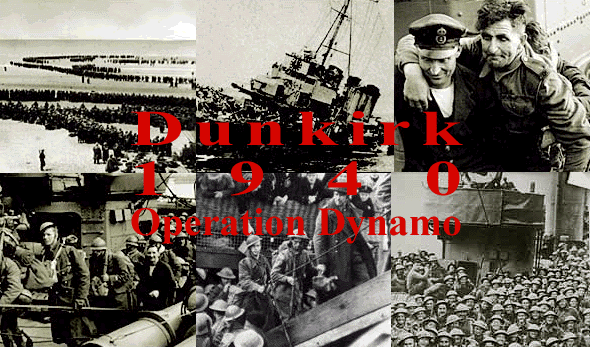Hundreds of civilian ships helped the soldiers to escape.
More than 300,000 troops were evacuated from Dunkirk
and the surrounding beaches in May and June 1940.
At the time the British Prime Minister Winston Churchill said it was
"a miracle of deliverance".
Dunkirk writer David J. Knowles explains what happened.
"A miracle" - is the best description of what happened at Dunkirk in May and June 1940.
Hundreds of thousands of troops were rescued from the jaws of the relentless German advance in the nick of time.
The troops were desperately needed back on the home shores to help defend against being invaded ourselves.
They were rescued from the harbour and beaches near to Dunkirk by a curious assembly of many different types of craft.
Many of the little ships, such as motor yachts, fishing boats and all manor of other such craft, were privately owned.
German forces underestimated
Although a large number of these ships were taken across the channel by navy personnel -
many were also taken over by their owners and other civilians,
all eager to help in what had become a catastrophe.
The British, French and Belgium governments had seriously underestimated the strength of the German forces in their equipment, transport and fire power - which was far superior to much of our outdated armoury.
Consequently the British Expeditionary Force, as well as the French and Belgian forces, found themselves defending positions against overwhelming odds.
Desperate retreat
Before long, with the Germans effectively cutting off nearly all of the escape routes to the channel, the BEF found itself desperately retreating to the harbour and beaches of Dunkirk.
Vice Admiral Ramsay - who was in charge of Operation Dynamo - had sent destroyers and transport ships to evacuate the troops, but they only expected to have time to lift off about 30,000 troops.
However, before long, the harbour became partially blocked by ships sunk in consistent attacks from enemy aircraft. It became necessary to take the troops off the nearby beaches as well - something that was thought to be an almost impossible task because of shallow water.
Seemed like a victory

This is when the little ships came to play their part.
A variety of motor boats, fishing smacks, trawlers, lifeboats,
paddle steamers and many other types of craft came over the channel to assist in the escape.
They mainly ferried the troops from the beaches to the destroyers laying offshore - but thousands of troops came all the way back to England in some of these boats.
The escape captured the minds and hearts of the British people at a time when it looked probable that we too would soon be invaded.
It seemed like a victory in just getting the troops back - over a third of a million of them - to fight another day.



